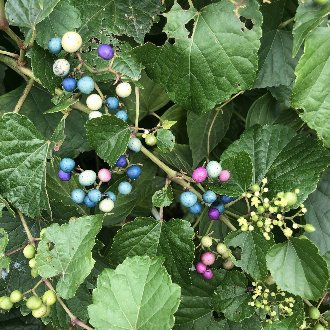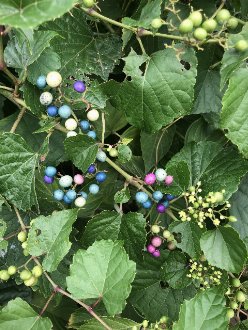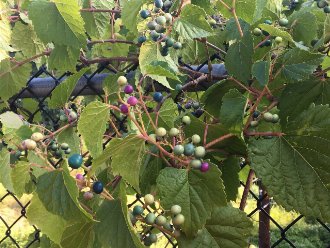Porcelain Berry (Ampelopsis glandulosa (Wall.) Momiy.)
Also known as Amur peppervine; also classified as Ampelopsis brevipedunculata (Maxim.) Trautv.
The species formerly considered Ampelopsis brevipedunculata is treated by most authorities, including BONAP and POWO, as merged into Ampelopsis glandulosa as var. brevipedunculata. To our knowledge, almost all, possibly all instances of this species in the wild in North America are of this variety, but there are four other varieties in this species' native range in East Asia.
↑Summary
A woody vine that resembles grapes, but has fruit that are bright blue at maturity. Native to east Asia, and introduced in North America, where it is considered invasive. In North America most abundant from the mid-Atlantic up into New England, but also found at scattered sites farther from this region.
↑Habitat
In North America, mostly found on disturbed sites and in degraded ecosystems, especially at forest edges and gaps. Humans have greatly increased habitat that this species favored by fragmenting forests and creating more edge habitat.
↑Life Cycle
Seed germinates after a period of moist, cool dormancy, in response to rising temperatures. Germination is improved by scarification and removal of fruit pulp, and thus is probably improved by passing through the digestive system of birds and other animals.
Germination is highest in areas of exposed soil, especially when the soil has been disturbed. Young plants prefer abundant sunlight but tolerant some shade. Seedlings quickly establish a taproot, which grows horizontally if the soil does not allow downward growth, and which occasionally branches.
Growth is rapid, but aboveground parts of the plant are rather flimsy, even relative to other vines. Plants invest significant energy in roots, and are able to resprout from roots following removal of aboveground parts. Resprouting plants often generate abundant tall, thin stems that angle upward to reconnect with structural supports.
Vines grow to 10-25 feet in length, occasionally more. Plants are often able to grow 10-15 feet in a single season, especially when supported by a well-established root system.
↑Uses
Occasionally planted as a landscaping plant, where it is valued for the unusual blue color of its berries. As it is now known to be invasive, its intentional planting is declining and most focus is on control and removal.
In east Asia this plant has several uses in traditional medicine.
↑Related Plants
There are five Ampelopsis species in North America, three introduced and two native. This species is probably closest-related to the two other introduced species: monkshoodvine (Ampelopsis aconitifolia) and Ampelopsis humulifolia.
The native heartleaf peppervine (Ampelopsis cordata) has a more southerly and westerly distributions than this one, but overlaps somewhat with it in range. Peppervine (Nekemias arborea) is also closely related, and has even been placed in this genus by some authorities, but is generally agreed-upon to be slightly less closely-related.
↑Links & External Resources
• Amur Peppervine | Fire Effects Information System (FEIS) (About This Site)
• Ampelopsis brevipedunculata (Porcelain Berry) | USDA PLANTS Database (About This Site)
• Porcelain Berry | iNaturalist (About This Site)
• Ampelopsis brevipedunculata (Amur Peppervine) | Missouri Botanical Garden Plant Finder (About This Site)
• Ampelopsis glandulosa | Biota of North America Project (BONAP) (About This Site)
• Ampelopsis glandulosa | Go Botany (About This Site)
• Ampelopsis brevipedunculata | NatureServe Explorer (About This Site)
• Ampelopsis glandulosa | Flora of North America (About This Site)
• Porcelain Berry | Maryland Biodiversity Project (About This Site)
• Ampelopsis glandulosa (Wall.) Momiy. | Plants of the World Online (POWO) (About This Site)






